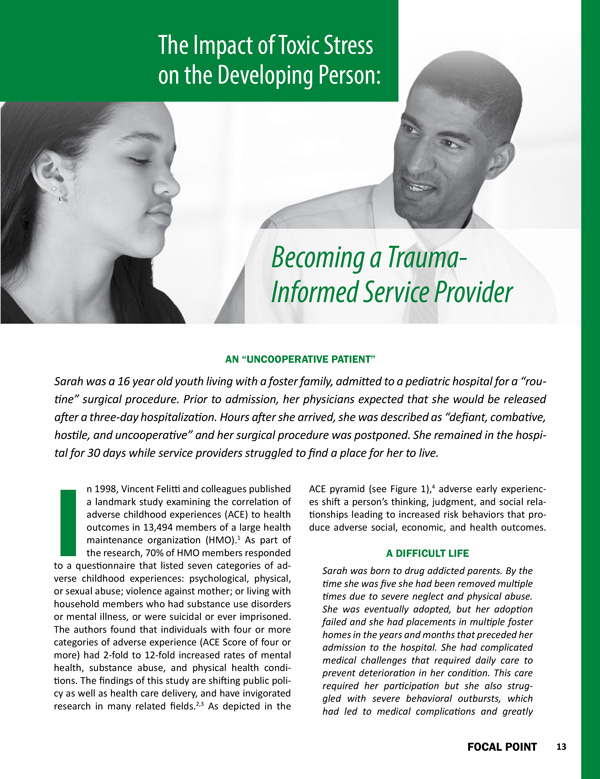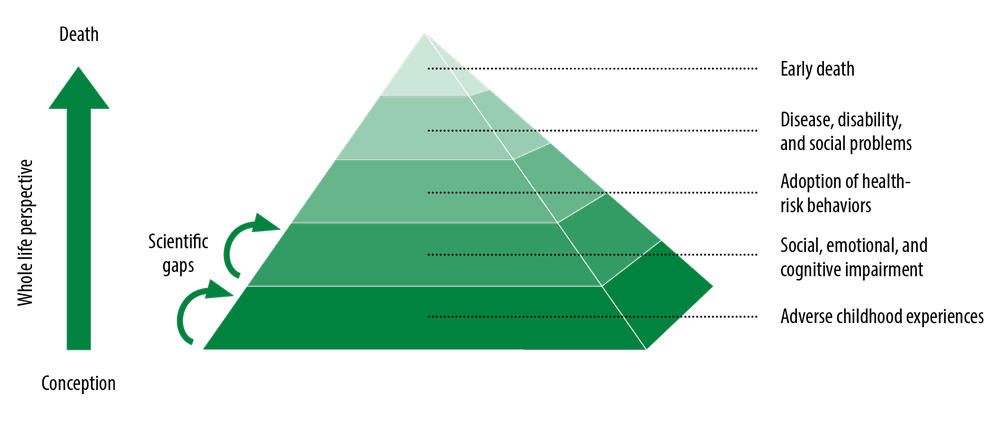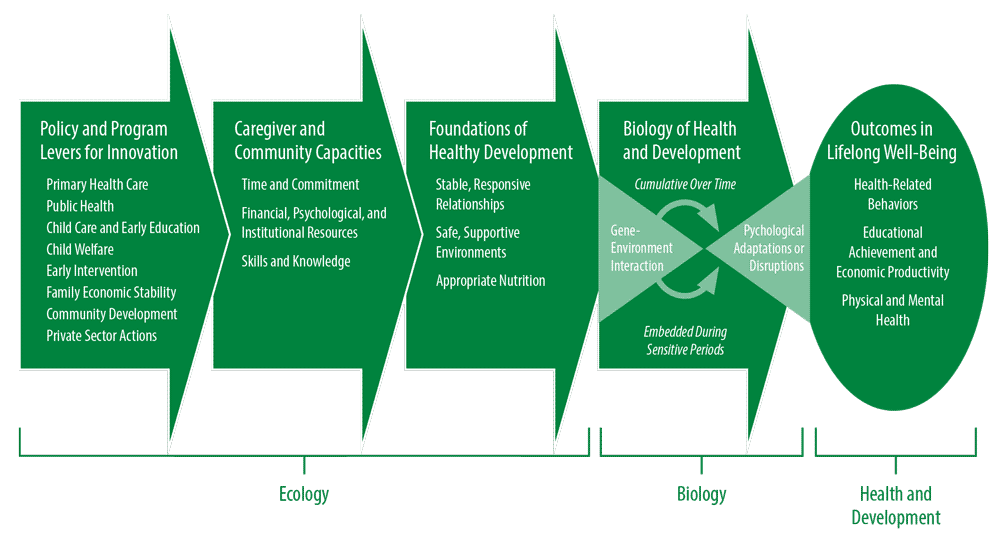
Abstract: This article spotlights the influence of toxic stress on behavioral regulation and emphasizes the necessity of a trauma-informed relationship between young adults and their service providers.
"The Impact of Toxic Stress on the Developing Person: Becoming a Trauma-Informed Service Provider" (2015)
An "Uncooperative Patient"
Sarah was a 16 year old youth living with a foster family, admitted to a pediatric hospital for a "routine" surgical procedure. Prior to admission, her physicians expected that she would be released after a three-day hospitalization. Hours after she arrived, she was described as "defiant, combative, hostile, and uncooperative" and her surgical procedure was postponed. She remained in the hospital for 30 days while service providers struggled to find a place for her to live.
In 1998, Vincent Felitti and colleagues published a landmark study examining the correlation of adverse childhood experiences (ACE) to health outcomes in 13,494 members of a large health maintenance organization (HMO).1 As part of the research, 70% of HMO members responded to a questionnaire that listed seven categories of adverse childhood experiences: psychological, physical, or sexual abuse; violence against mother; or living with household members who had substance use disorders or mental illness, or were suicidal or ever imprisoned. The authors found that individuals with four or more categories of adverse experience (ACE Score of four or more) had 2-fold to 12-fold increased rates of mental health, substance abuse, and physical health conditions. The findings of this study are shifting public policy as well as health care delivery, and have invigorated research in many related fields.2 3 As depicted in the ACE pyramid (see Figure 1),4 adverse early experiences shift a person's thinking, judgment, and social relationships leading to increased risk behaviors that produce adverse social, economic, and health outcomes.
Figure 1. The ACE Pyramid

A Difficult Life
Sarah was born to drug addicted parents. By the time she was five she had been removed multiple times due to severe neglect and physical abuse. She was eventually adopted, but her adoption failed and she had placements in multiple foster homes in the years and months that preceded her admission to the hospital. She had complicated medical challenges that required daily care to prevent deterioration in her condition. This care required her participation but she also struggled with severe behavioral outbursts, which had led to medical complications and greatly limited options for stable living situations. Families who cared for her quickly found themselves in power struggles leading to a long string of failed placements.
"Defiant, combative, hostile, and uncooperative" were labels used by many people who knew Sarah... but what if we saw her as "frightened, struggling to cope, confused, and abandoned" and dealing with the effects of extreme stress?
Toxic Stress
One can think of stress as on a spectrum from normal health building stress (exercise) to toxic, overwhelming stress. It is toxic levels of stress that adversely impact health through the release of chronic stress hormones which impact gene expression, memory, learning, and brain development.
Poorly regulated behaviors and emotions further impact social, academic, and vocational functioning leading to cycles of failing and destructive experiences. People who have traumatic histories may interpret routine communications as hostile and respond with a fight or flight reaction that is out of proportion, from the perspectives of others. When these behaviors are interpreted from a typical lens, the result is often misunderstanding and escalating patterns of negative communication or avoidance. Over time the individual comes to expect poor outcomes and enters triggering situations (such as health care settings) with anticipatory fear and anger or avoidance.
The Developing Person
Human development is the result of a complex interplay between gene and environment during brain development and through a cumulative process of building capacities. The foundations of healthy development depend on stable and secure relationships, which are influenced by a myriad of factors ranging from family structure and function to public policy and generational cultural influences. This is well represented in a diagram from an article entitled "The Lifelong Effects of Early Childhood Adversity and Toxic Stress"5 (see Figure 2).
Figure 2. An Ecobiological Framework for Early Childhood Policies and Programs

Brain development is a sequential process with the formation of primitive structures first (brain stem controlling basic functions such as breathing and heart rate), progressing eventually to cortical structures responsible for complex thought and emotional regulation. The process is punctuated by a number of sensitive periods where brain cells (neurons) respond to environmental experience. Some neurons are experience-dependent, meaning that their survival depends on appropriate and organized stimulation. A disorganized, traumatic, or under-stimulating environment has lifelong impacts on this complex process. The timing of trauma and neglect may result in later challenges, which reflect the associated developmental periods affected. Struggles with becoming easily overwhelmed with sensory experiences, regulation of emotions, processing of information, understanding language, and the development of effective interpersonal skills are related to specific brain regions and developmentally sensitive periods. Knowledge of these complex processes and residual effects may shape our understanding and result in better-targeted therapies for each individual.6,7
Healthy Relationships are Protective
The quality of relationships and attachment between caregivers and their children may be defined by distinctive types of child responses to separation,8 and the type of attachment is predicted by the parents' recollection of relationships and attachment to their parents.9 This generational transmission of relational health interacts with environment and genetics to create vulnerability and resilience in the face of environmental stress. Secure attachments provide protective and reparative capacity in the face of what would otherwise become toxic stress.10
Trauma-Informed Approach
An understanding of the impact of trauma on the developing person creates a frame for how organizations and individuals can design services that create a sense of safety, which is the foundation of healing relationships. The Substance Abuse and Mental Health Services Administration (SAMHSA) lists six core principles for trauma-informed care: (a) Create a sense of safety; (b) Practice trustworthiness and transparency; (c) Utilize collaboration and mutuality; (d) Practice empowerment; (e) Foster voice and choice; and (f) Recognize cultural, historical, and gender issues.11 While working with Sarah, service providers incorporated trauma-informed principles in their practice.
Helping Sarah
When the child psychiatrist and the resident entered Sarah's room, she was on the phone yelling at the person on the other end. The interviewer sought to introduce himself and Sarah yelled "Shut up!"
When caregivers are confronted with another human being in distress, how we choose to support that person is informed by our understanding of what is causing the distress. If we think she is rude and inconsiderate and needs to use better behavior, we might say "That's not appropriate"...or... "You can't use the phone if you are yelling at people." The consultants in this case assumed that the behavior was a sign that Sarah was struggling to cope and needed support.
The interviewer started with an empathetic stance and said: "Sorry, I'm just going to wait until you're free." When Sarah hung up she was crying and exclaimed, "Don't you know it's hard for me to understand two people taking at once!" Response: "Sorry Sarah, thank you for explaining that to me." "You're really upset; can you tell me what's going on?" They got permission to sit at eye level and gave her space. They learned about her struggles through gathering information, reassuring, reflecting, and some educated guessing. That was followed by strategizing with Sarah about how to get her needs met as well as the needs of staff and other young people on the floor (collaborative spirit). The psychiatry team also gathered information from Sarah's caseworker. They learned about her many losses, her interests in animals and art, her sense of humor and her desire to stick up for others (strengths). They also learned that she had learning challenges of various types and struggled with loud noises and speech (lagging skills). The medical team was informed about her history and the impact of trauma and loss on her behaviors. The consultants discussed strategies to avoid power struggling and triggering of explosive behavior.
Overall this approach was consistent with the philosophy of Collaborative Problem Solving as defined by the Think:Kids program at Massachusetts General Hospital (see http://www.thinkkids.org). This approach utilizes the frame that youth do well if they can, and if they are struggling, it is the adults' job to understand why. Ultimately the goal is to improve the skills of the young person rather than impose the will of the adult.
Over time Sarah let her caregivers help. She formed relationships with them and navigated her medical care as a partner with her team. Physical and chemical restraints were avoided throughout her stay and the nursing staff grew fond of her. She was eventually placed with a family who celebrated Sarah's strengths and invited her to join in solving the challenges of her day to day life.
A Changing Paradigm
The ACE study and subsequent analysis and investigation are driving changes in health care policy and delivery. Health care costs are directly correlated to early childhood experience. Understanding and preventing child maltreatment, improving resilience, and building skills for later life form the foundation for a healthier population. Researchers, service providers, and policymakers are investigating and implementing a range of principles and promising approaches to supporting traumatized individuals. All of us have the opportunity to improve our ability to help others by shifting our explanation of the actions and emotions of those we wish to support.
References
- Felitti, V. J., Anda, R. F., Nordenberg, D., Williamson, D. F., Spitz, A. M., Edwards, V., . . . Marks, J. S. (1998). Relationship of childhood abuse and household dysfunction to many of the leading causes of death in adults: The Adverse Childhood Experiences (ACE) study. American Journal of Preventive Medicine, 14, 245–258.
- Dietz, P. M., Spitz, A. M., Anda, R. F., Williamson, D. F., McMahon, P. M., Santelli, J. S., . . . Kendrick, J. S. (1999). Unintended pregnancy among adult women exposed to abuse or household dysfunction during their childhood. Journal of the American Medical Association, 282, 1359–1364.
- Hillis, S. D., Anda, R. F., Dube, S. R., Felitti, V. J., Marchbanks, P. A., Macaluso, M., & Marks, J. S. (2010). The protective effect of family strengths in childhood against adolescent pregnancy and its long-term psychosocial consequences. Permanente Journal, 14(3), 18–27.
- Centers for Disease Control. (2014). Adverse Childhood Experiences study. Injury Prevention & Control: Division of Violence Prevention. Retrieved from: http://www.cdc.gov/violenceprevention/acestudy
- Shonkoff, J. P., Garner, A. S., Siegel, B. S., Dobbins, M. I., Earls, M. F., McGuinn, L., . . . Wood, D. L. (2012). The lifelong effects of early childhood adversity and toxic stress. Pediatrics, 129(1), 232-246.
- Perry, B. (2004). Understanding traumatized and maltreated children: The core concepts – Living and working with traumatized children. The Child Trauma Academy. Retrieved from: http://www.lfcc.on.ca/Perry_Core_Concepts_Violence_and_Childhood.pdf
- Van Der Kolk, B. A. (2006). Clinical implications of neuroscience research in PTSD. Annals of the New York Academy of Sciences, 1071, 277-293.
- Ainsworth, M. D. S., Blehar, M. C., Waters, E., & Wall, S. (1978). Patterns of attachment: A psychological study of the strange situation. Hillsdale, NJ: Erlbaum.
- Main, M., & Goldwyn, R. (1995). Adult attachment classification system. In M. Main (Ed.), Behavior and the development of representational models of attachment: Five methods of assessment. Cambridge, UK: Cambridge University Press.
- Bowlby, J. (1988). A secure base: Parent-child attachment and healthy human development. New York, NY: Basic Books.
- Flatow, R. B., Blake, M., & Huang, L. N. (2015). SAMHSA's concept of trauma and guidance for a trauma-informed approach in youth settings. Focal Point: Youth, Young Adults, & Mental Health, 29, 32-35.
Suggested Citation
Jetmalani, A. (2015). The Impact of Toxic Stress on the Developing Person: Becoming a Trauma-Informed Service Provider. Focal Point: Youth, Young Adults, and Mental Health, 29, 13-16. Portland, OR: Research and Training Center for Pathways to Positive Futures, Portland State University.